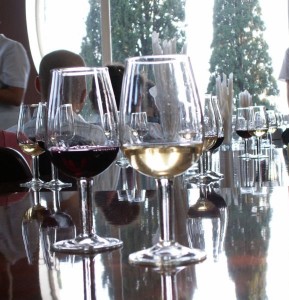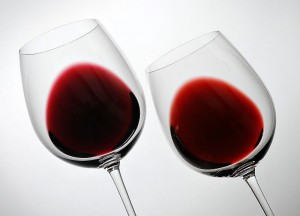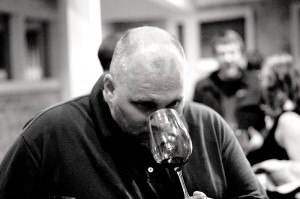
One of the questions I am most frequently asked by people new to the world of rare and boutique wines is “What is the right way to taste wine?” The simplest answer is “There is no one right way to taste wine.” However, there are a number of things you can do to enhance your ability to distinguish between the nuances and flavors present in each wine and learn to tell a “good” wine from one that is not quite as pleasing.
The basic principles of wine tasting are simple to learn. Once you have built a foundation based on these essentials, you will develop a natural understanding of the nuances and finer details of wine tasting. Your senses of taste, smell, and sight, along with the shape of glass and temperature of the wine, all come together to mold the tasting experience. Just like any other pursuit, learning to taste wine takes practice and experience. Fortunately, practicing wine tasting is a very enjoyable activity!
Especially in the beginning, it can be very helpful to have a friend along on your wine tasting adventures who is experienced in the subject. You friend will be able to answer questions you may have and his or her observations on flavors or aromas in the wine may spark recognition of the flavor as you taste it. Having a knowledgeable friend will help you to quickly become more comfortable in what can sometimes be a dauntingly complex pursuit.
It can also be very helpful when starting out to select a series of wines that share some common element such as varietal or region of origin. You may be surprised at the stark contrasts between two Cabernet Sauvignons from different growing regions.
Before You Pour – Glass
The type of wine glass you use for a wine serves both aesthetic and functional purposes. For wine tasting we are most concerned with how the shape of the glass affects the flavors and aromas of the wine. It is a fact that the shape of a glass has an effect on the taste of a wine and that certain shapes are better suited to certain wines than others. Again, this is a topic which I discuss at length in another article here. But suffice it to say that for most wine tasting purposes you should choose a glass which is wide enough in the bowl to allow swirling of the wine and sufficient exposure to air, but narrow enough at the top to concentrate the aromas and bouquet of the wine.
The cleanliness of the glasses you are using is a sometimes overlooked but crucial consideration. Detergent residue or mineral deposits left over from hard water not readily visible to casual observation will dissolve into the wine and impart their own flavors or change the taste of the wine. Wine glasses should be hand washed with a mild dish or “bar keepers” soap and rinsed very well. Towel dry your glasses to ensure that water spots or mineral deposits will not be left behind.

Before You Taste – Temperature
An important element of wine tasting that is often misunderstood is the proper serving temperature of the wine. The temperature at which a wine is served has a significant impact on the way it tastes and smells.
Most people are familiar with the old “rule-of-thumb” that a white wine should be chilled and a red should be served at “room temperature.” This is partly true. A Sauvignon Blanc will usually taste dull and uninteresting when warm and a Cabernet Sauvignon will often be somewhat bitter and not display its full character when too cold. However, serving a white wine right out of the refrigerator or a red wine right off of your rack can be just as bad.
Each wine varietal has its own ideal serving temperature and none of them are the typical 35 degrees F of a refrigerator or 70 degrees F of the typical modern room temperature. I go into the details of this in a separate article, but for most purposes, it is wise to allow white wines to sit outside the refrigerator for 20 – 30 minutes before drinking. Likewise you will want to put your red wine in the fridge for 10 – 15 minutes before drinking.
The Sensory Nature of Wine Tasting
Wine tasting requires that we utilize much more than just our taste buds. Your taste buds, or palate, have the ability to discern only four basic flavors. The combinations of these flavors – sweet, sour, saltiness, and bitterness – is what determines how your taste buds interpret what is in your mouth and communicate it to the brain. But that is only a fraction of the picture. A significant amount of what we regard as taste or flavor is actually determined by your sense of smell. While there are only four basic flavors, there are several thousand different scents. You can explore this by holding your nostrils shut next time you try your favorite food or wine. There is also the sense of touch you experience as a wine flows across your mouth. Some wines may be thicker, thinner, oily, smooth or more watery in texture than others.
Where most people run into trouble is that much of what we do and perceive every moment of our lives is done unconsciously and without deliberate thought or awareness. Making a concentrated effort to pay attention to your senses and be vigorously aware of what they are telling you will make a tremendous difference in how you perceive the tastes and aromas of the wines you sample. The ability to be in tune with your senses is one of the things that separates a wine expert from the ordinary wine drinker.
Beyond the sensory element of wine tasting, you will want to develop a vocabulary that allows you to express and articulate what your senses are telling you as well as become accustomed to a particular method or pattern in your tasting. These are things that come with time and practice. Consistency will be an important part of your development as a wine taster.

The Visual Nature of Wine Tasting
Before you even smell or taste a wine, the visual appearance of a wine can give you a lot of information. After pouring a glass of wine, hold the glass up to the light and take a look at the clarity of the liquid. In some wines such as an unfiltered, full-bodied red wine, some amount of haziness may be allowed. However, in most other styles it may be a cause for concern.
The color present in a wine along the thin edge clinging to the glass can tell you something about its maturity. A amber hue in a white wine generally indicates an aged wine. A matured red will typically express a vivid crimson color. Excessive browning on the other hand may indicate a wine that has passed its prime.
As you visually examine the wine, give it a light swirl in the glass. The wine sticking to the sides of the glass – its legs – will give you an indication of the texture and alcohol content in the wine. More wine clinging to the sides means a higher percentage of alcohol.
The Bouquet of Wine Tasting
After visually inspecting the wine, give it another swirl in the glass to release its aroma or bouquet. Hold the glass closely up to your nose and inhale deeply. Again, there is no right way to sniff the wine. Some people take several short breaths, others take one strong inhalation. Find a technique that works for you.
Agitating the wine by swirling the glass releases its vapors and the thin film on the side of the glass evaporates rapidly, releasing the molecules that make up the wine and allow them to reach your olfactory membranes. It is your sense of smell that enables you to perceive many of the more subtle tastes in each glass of wine.

In the beginning, you may have difficulty identifying the scents and flavors that the wine presents. It may be helpful to simply list off the first thoughts or impressions that come to your mind, no matter how peculiar they may seem at the time. If you have trouble identifying the aromas of a wine, give it a rest for a few minutes and then try it again. As time goes on and you experience more wines, you will find the aromas gaining definition in your mind and becoming easier to describe. This is a place where having an experienced friend along can serve a great benefit.
Try to compare the smells you sense into with other similar wines you have tasted or with previous tastings of the same wine. The ability to distinguish and contextualize the “Nose” of a wine will serve as a foundation for building your knowledge and experience in wine tasting.
The Taste of Wine Tasting
Once you have experienced the visual and aromatic elements of the wine, the natural next step is to actually taste the wine. Whether to swallow or spit is a matter of personal and situational preference and may depend on the number of wines you will taste. Becoming inebriated will, of course, alter your perception of the wines you taste.

Give your glass another swirl and draw a small sip of the wine into your mouth. Note your first impressions. Again, taking special care to be aware of your senses and what they are telling you. Take a slightly larger sip, allowing it to coat the inside of your mouth. Pay attention to the way the wine “feels” in your mouth, the touch. Think about the wine’s texture; its body or depth of flavor; the astringency or bitterness of the tannins; the dry or smooth nature of the wine; and its alcohol content. Aerate the wine for a moment by swishing it in your mouth. This agitation releases additional flavor and aroma, enhancing the flavors of the wine. Take the time to experience the sensations that your senses of taste and smell are presenting to you. Don’t over think the flavors, but go with your impressions and feel the nuances of the wine unfold.
Wine tasting is a skill that will stay with you for life and will grow and evolve over time. Learning to be more in tune with your senses through wine tasting will give you a greater appreciation for the wide range of flavors and styles of wine and enhance your enjoyment of the wines you drink. Remember the steps; Observe, smell, then taste. Have fun with it, and remember to “Always drink good wine!™“
Whenever you have questions about selecting a wine or wine tasting, be sure to give me a call at 415-337-4083 or visit http://www.GoldenGateWineCellars.com
One thought on “Wine Tasting 101: The Complete Guide for Everyone”
Leave a Reply
You must be logged in to post a comment.

Great site!!!